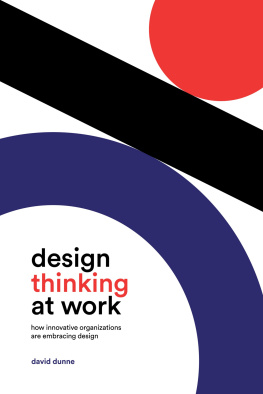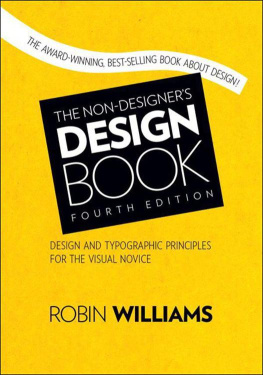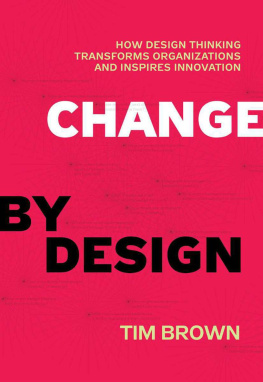Design thinking is the core creative process for any designer; this book explores and explains this apparently mysterious design ability.
Focusing on what designers do when they design, Design Thinking: Understanding How Designers Think and Work is structured around a series of in-depth case studies of outstanding and expert designers, interwoven with overviews and analyses. The range covered reflects the breadth of design, from hardware and software design to architecture and Formula One. The book offers new insights into and understanding of design thinking, based on evidence from observation and investigation of design practice.
Design Thinking is the distillation of the work of one of designs most influential scholars. Nigel Cross goes to the heart of what it means to think and work as a designer. The book is an ideal guide for anyone who wants to be a designer or to know how good designers work in the field of contemporary design.
DESIGN
THINKING
UNDERSTANDING HOW
DESIGNERS THINK AND WORK
Nigel Cross

English edition
First published in 2011 by
Berg
Editorial offices:
First Floor, Angel Court, 81 St Clements Street, Oxford OX4 1AW, UK
175 Fifth Avenue, New York, NY 10010, USA
Nigel Cross 2011
All rights reserved.
No part of this publication may be reproduced in any form
or by any means without the written permission of
Berg.
Berg is the imprint of Bloomsbury Publishing Plc.
Library of Congress Cataloging-in-Publication Data
A catalogue record for this book is available from the Library of Congress.
British Library Cataloguing-in-Publication Data
A catalogue record for this book is available from the British Library.
ISBN 978 1 84788 637 8 (Cloth)
978 1 84788 636 1 (Paper)
e-ISBN 978 1 84788 846 4 (Individual)
Typeset by JS Typesetting Ltd, Porthcawl, Mid Glamorgan
Printed in the UK by the MPG Books Group
www.bergpublishers.com
CONTENTS
My friends Gordon Murray and Kenneth Grange freely and readily gave the time and patience to discuss their work with me, reported in , all providing their time and talent free of charge, and allowing their design activity to be observed, recorded and analysed. My colleagues at the Delft University of Technology, Kees Dorst and Henri Christiaans, provided the initiative and the hard work in the design and conduct of the experiments. The facilities for the experiments were provided by the Xerox Palo Alto Research Center, with the help of Steve Harrison and Scott Minneman. My wife Anita also contributed to analysing the experiments, to discussions with Gordon and Kenneth, and to my general well-being.
In writing this book, my goal has been to help anyone interested in design to develop their understanding of how designers think and work. Anyone so interested might be a design student, a design researcher or teacher, a manager in a design-oriented company, or even a designer who still finds their own processes mysterious or difficult. The focus of the book is on revealing what designers do during the activity of designing, and on building an understanding of the nature of design ability. Readers should gain from the book some insight into what it means to be a designer, how designers employ creative thinking skills, and what is known about different aspects of design ability and its development from novice student to expert professional.
My own background includes architecture and industrial design, but primarily I am a design researcher with an interest in the common aspects of designing that recur across different professional domains of practice. My approach to trying to understand how designers think and work is research-based: I look for and report evidence that comes from observation, experiment, analysis and reflection. My aim is to reveal and articulate the apparently mysterious (and sometimes deliberately mystified) cognitive and creative abilities of designers, that are common across many design domains.
At the core of the book is a number of case studies, each treated in depth as a complete chapter. These are interlaced with chapters that summarise and discuss what can be learned from the case studies in more general terms, and from the research literature of studies of design cognition. The case studies provide a focused resource for the study of high-quality design thinking. The summary and overview chapters provide discussion and reflection that I hope lead the reader into a deeper understanding of the nature of design thinking. This not a methods or how-to book, but a book that reveals what has been learned from research into many different aspects of design thinking. It is a book that provides commentary and advice, rather than instruction.
The first two case studies () are experiment-based research studies, using an expert engineering designer and a small, high-quality product design team each tackling the same project in a recorded, laboratory situation. In addition to the observations to be made, and lessons to be drawn from these particular case studies, I draw upon the research literature in order to amplify and extend from the particular to the general.
I take an interdisciplinary approach to design, so throughout the book observations are made, and comparisons are drawn, across various professional fields such as architecture, product, engineering and automotive design. Other professional design domains, such as computer software and interaction design, furniture, textiles and graphic design are also mentioned. But because I take a research-based approach to understanding design thinking, some domains get less coverage in the book simply because less research has been conducted in them. Nevertheless, I believe that many aspects of design thinking are common across the different domains, and so I trust that my observations and comments will be valid across them all.
1
Design Ability
Our job is to give the client, on time and on cost, not what he wants, but what he never dreamed he wanted; and when he gets it, he recognises it as something he wanted all the time.
Denys Lasdun, architect.
Everyone can and does design. We all design when we plan for something new to happen, whether that might be a new version of a recipe, a new arrangement of the living room furniture, or a new layout of a personal web page. The evidence from different cultures around the world, and from designs created by children as well as by adults, suggests that everyone is capable of designing. So design thinking is something inherent within human cognition; it is a key part of what makes us human.
We human beings have a long history of design thinking, as evidenced in the artefacts of previous civilisations and in the continuing traditions of vernacular design and traditional craftwork. Everything that we have around us has been designed. Anything that isnt a simple, untouched piece of nature has been designed by someone. The quality of that design effort therefore profoundly affects our quality of life. The ability of designers to produce effective, efficient, imaginative and stimulating designs is therefore important to all of us.
To design things is normal for human beings, and design has not always been regarded as something needing special abilities. Design ability used to be somehow a collective or shared ability, and it is only in fairly recent times that the ability to design has become regarded as a kind of exceptional talent. In traditional, craft-based societies the conception, or designing, of artefacts is not really separate from making them; that is to say, there is usually no prior activity of drawing or modelling before the activity of making the artefact. For example, a potter will make a pot by working directly with the clay, and without first making any sketches or drawings of the pot. In modern, industrial societies, however, the activities of designing and of making artefacts are usually quite separate. The process of making something does not normally start before the process of designing it is complete.













